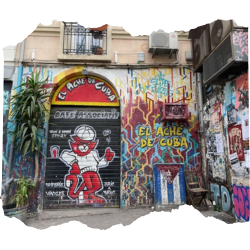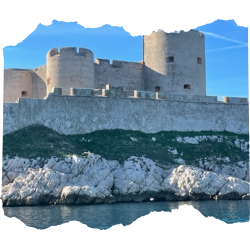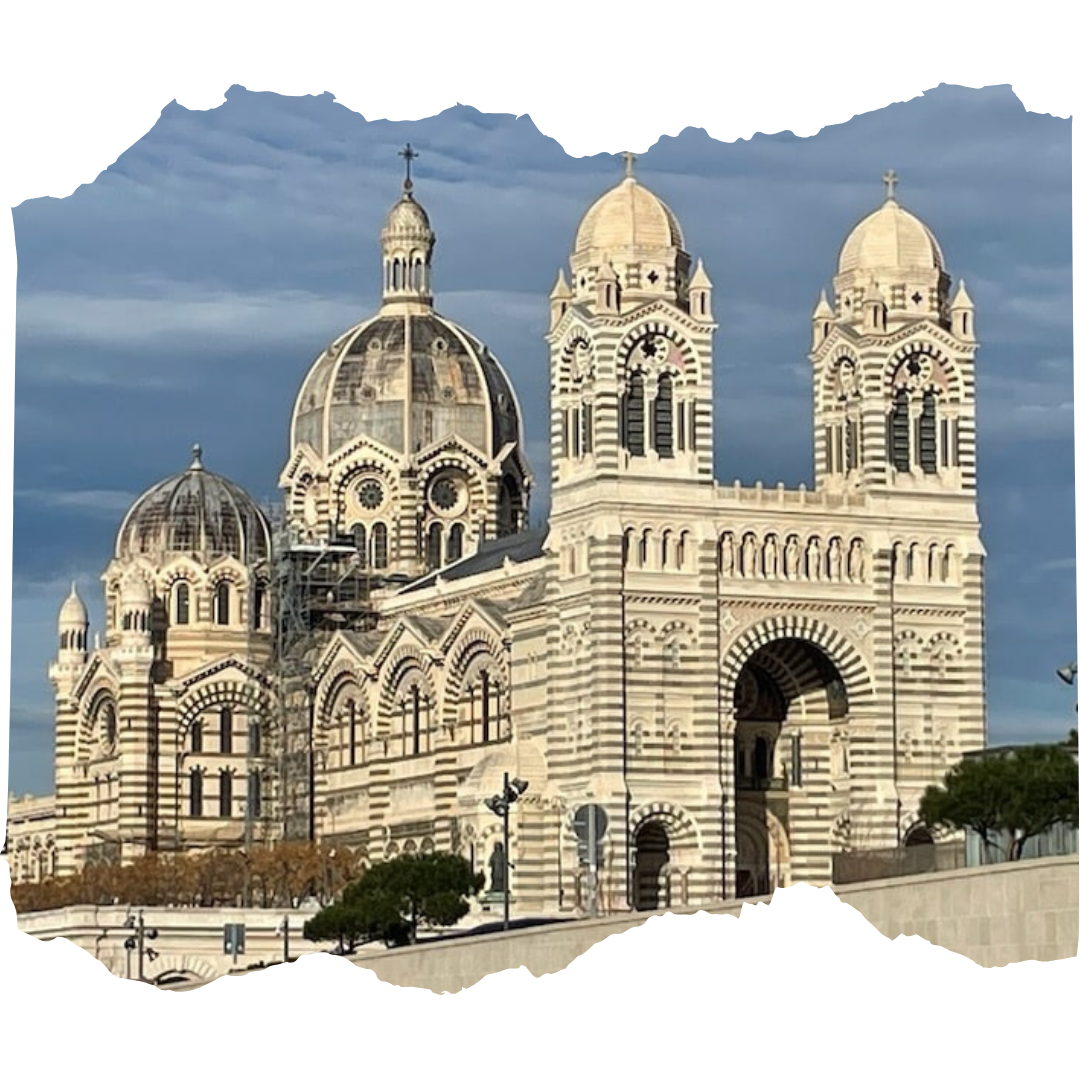Unsure about your French table manners? Click Here to download > > How to avoid these 10 food etiquette mistakes !
- Home ›
- Destinations ›
- Southern France ›
- Savon de Marseille
How Marseille Soap Is Making A Comeback - and why it's a problem
Published 8 March 2024 by Leyla Alyanak — Parisian by birth, Lyonnaise by adoption, historian by passion
Savon de Marseille is an iconic French soap that is taking the world by storm – again. Once popular, it fell into disuse but now, as people search for “natural” products, it is on its way back. This is the soap’s rocky comeback story.
Marseille soap is an iconic product of France that is taking the world by storm – again. Once popular, it fell into disuse for a while but now, as people search for “natural” products, it is fiercely on its way back. This is the soap’s story.
You’ll smell La Licorne soap factory before you reach it, that familiar velvety scent you know but can’t really identify. Wisps of olive oil with streams of lavender, citrus, rose, orange blossom, everything that reminds us of sunshine.
What is it about this soap from Marseille, and why did someone give me a box of it for Christmas? I always thought it was something my grandmother had used, but…
NOTE: Pages on this site may contain affiliate links, which support this site. See full Privacy Policy here.
Marseille soap, or Savon de Marseille, is making a major comeback. Tired of chemicals and allergies, people are seeking natural alternatives and this traditional soap, which has been around for centuries, fits the bill perfectly.
What’s the big deal about Marseille soap?
Plenty.
It’s as natural as natural can be
To qualify as Marseille soap, it must contain two things: 72% vegetable oil, and sodium carbonate.
You can use it for almost anything
It’s a multi-purpose soap of incredible purity which you can use for your face, your body and even your hair. It leaves everything in its wake soft and clean, with no thin film from synthetic additives. (Producers say you can also brush your teeth with it but, well, soap…)
It has plenty of other uses!
- To clean your sink and countertops (just rub the soap on a cloth)
- To clean leather – wet a cloth with hot water and melt a bit of soap on it
- To wash your hair – try mixing a teaspoon each of olive oil and honey, and a tablespoon of grated soap, then add boiling water until you get a paste (this will keep for a few weeks), then shampoo; you could also add some essential oils if you’d like
- To add scent to your drawers and cupboards…although in its purest state, Marseille soap will have a slightly pungent olive oil scent, not in the least unpleasant
It is utterly affordable
Prices vary from country to country but it isn't expensive and chunky cube that weighs 600 grams (1.3 lb) will last months.
It leaves your dry skin incredibly smooth and hydrated
I know, this isn’t a scientific explanation, but… it does. It is touted as good for even the most sensitive skin and all skin types, and is hypoallergenic. The virtues of Marseille soap seem endless!
All I can say is that when I use essential oils and wash my hands with the usual liquid soap, I have to wash them again. Savon de Marseille? Once is enough.
And of course, it’s magic!
I won’t call it an old wives’ tale, but there is a tradition that involves placing a cube of soap at the bottom of your bed between the sheets to allay cramps and rheumatism. Cramps might be due to a lack of salt, and the savon de Marseille is made with sea salt… so perhaps...
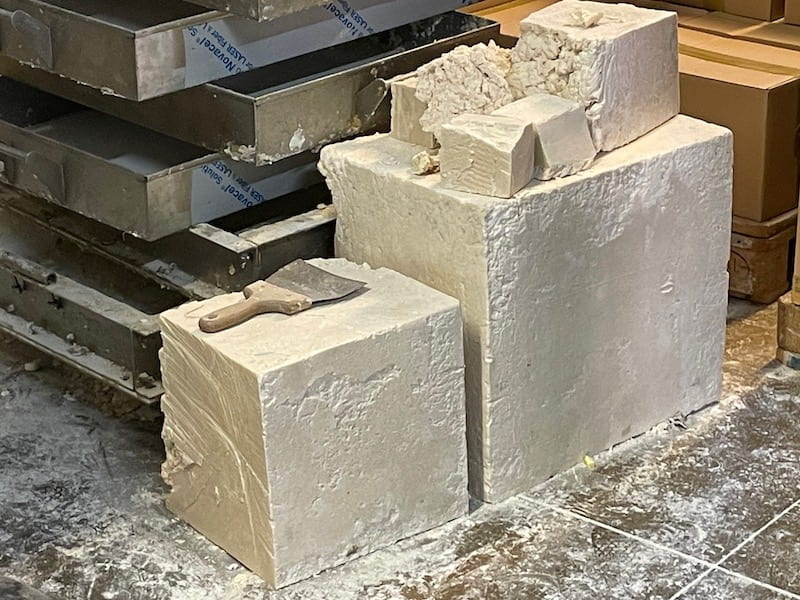 This is what Marseille soap looks like before it becomes the soap you can buy ©️Offbeat France/Leyla Alyanak
This is what Marseille soap looks like before it becomes the soap you can buy ©️Offbeat France/Leyla AlyanakThe story of soap
The history of soap stretches into Antiquity, to 2500 BCE or even 2800 if some sources are to be believed. And like most ancient methods and products, it has several tales of origin. It probably started with the mixing of animal fat and ashes sometime in prehistory, and likely in Mesopotamia, roughly in the region of modern-day Iraq.
In one later story, rain had been pouring when a Roman woman noticed the water mixing with ash and fat – and realized you could use it for hand washing clothes. And the women of Rome began using it to wash themselves.
Roman writings talk of Gauls in France using soap to dye their hair red or blond as far back as the first century CE, and references to soap pop up across Europe throughout the Middle Ages.
By then, Crusaders traveling back and forth between Europe and the Holy Land returned with plenty of soap from places like Aleppo, and its popularity spread, giving birth to what we call savon de Marseille. After all, it made sense that the south of France, a land rich in olive trees and salt from the Camargue, should develop a soap-making industry. The only difference with the soap from Aleppo was the absence of laurel as a main ingredient.
As the soap grew in popularity, it decreased in quality, and cheaper animal fats replaced some vegetable oils, which gave the soap an unpleasant smell. That simply would not do, and so the government of Louis XIV stepped in to legislate.
The Colbert Edict of 1688 would dictate the soap’s ingredients and production method: it would have to be prepared in large cauldrons, and only olive oil could be used. (The cauldrons are still in use today.) The suet – animal fats – that had been sneaking into soap would henceforth be forbidden. The soap would be sold in large blocks, or in smaller bars.
Marseille, a thriving port, quickly took the lead, and orders came in not only from France, but from other European countries.
Soap manufacturers opened up shop throughout the region, beyond Marseille, although bearing the name “Marseille” would always rank the city’s products a bit above the rest – even if there was no difference at all between it and soaps made in, say, Salon-de-Provence or Toulon. In fact, this not-so-subtle rivalry exists to this day, as I’ll explain below.
With the arrival of the Industrial Revolution, new techniques would speed up the soapmaking process, providing a boost for the industry, and advertising would spread the word far and wide.
The industry expanded and Marseille soap and its master perfumers quickly gained a reputation as the best in the world. By the time the 20th century rolled around, 90 soap makers in Marseille were making 180,000 tons of soap each year and one in three people were employed in the soap industry.
And then the wars happened, along with their financial crises. Production fell and in the 1950s, laundry detergent appeared on the market – cheap, time-saving and easy to use in powdered form in a modern washing machine. The need for traditional Marseille soap faded.
An unexpected resurgence
As the 20th century sped by, demand began to grow for more natural products. These days, tired of an increasingly chemical world, people are clamoring for unpolluted and non-allergenic goods, and are well aware of sustainability issues and waste. Re-enter the savon de Marseille, the perfect natural soap, and so began its comeback.
It is a close to pure soap as you can get, without coloring or perfume, without extra synthetics, just the soap. There are variations, with a few drops of essential oil, but the Savon de Marseille is what it is. The various colored and scented versions on sale are soaps, and they be nice soaps, but there is plenty of argument as to whether they qualify as authentic “savons de Marseille”.
How to choose genuine Marseille soaps
This should be easy to explain, but far from it. Because there's not official label governing either the name or the manufacturing process of Marseille soap, almost anything can call itself Marseille soap and get away with it.
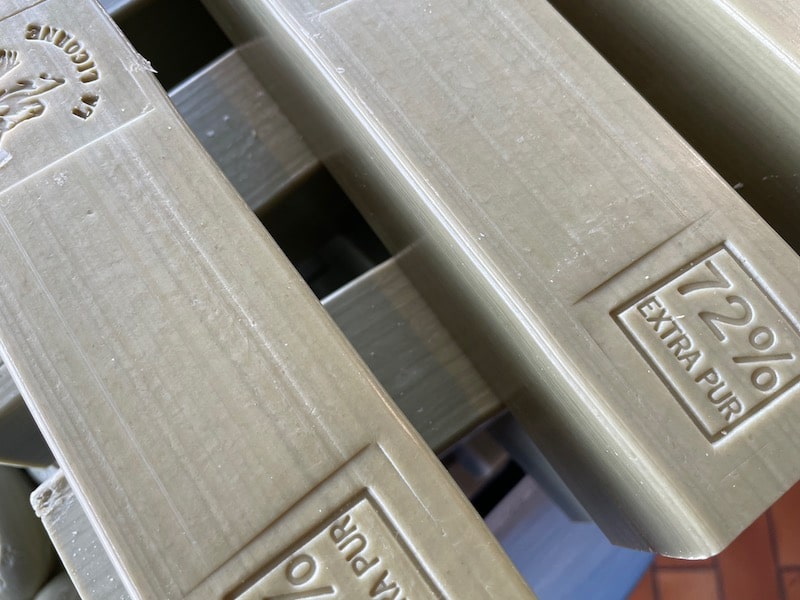 Bars of Marseille soap before they are prepared for sale ©Offbeat France/Leyla Alyanak
Bars of Marseille soap before they are prepared for sale ©Offbeat France/Leyla AlyanakGenerally, three things are needed to qualify as a traditional savon de Marseille:
- The right ingredients: at least 72% vegetable oil, preferably olive; sodium carbonate, or lye; water; and sea salt
- The right manufacturing process: saponification (heating vegetable oil with sodium carbonate); separating soap from water by using salt; boiling; washing; and a final wash in clean water (forgive my use of not very technical terms – I’m sure there are better ones!)
- The right origin: Marseille and its surrounding department of the Bouches-du-Rhône, #13. (Not sure what a “department” is in France? Here’s a full explanation.)
A “real” savon de Marseille will have a list of ingredients either on the wrapper, as a separate leaflet with the soap, or in the shop, to be brought out at your request. Don’t be timid and do check the ingredients.
Also look for the factory stamp on one side of the cube. There aren’t many soap factories and their stamps are quite distinct.
So it should be easy to tell the real thing from a fake.
Except… like many things in France, it’s complicated.
The color of Marseille soap
Traditional Marseille soap is either white/beige or olive green. So what about those attractive fancy pinks and purples? Are they authentic Marseille soap or not?
It depends.
Should adding a bit of food coloring prevent the soap from being authentic?
The answers are divided on this as well.
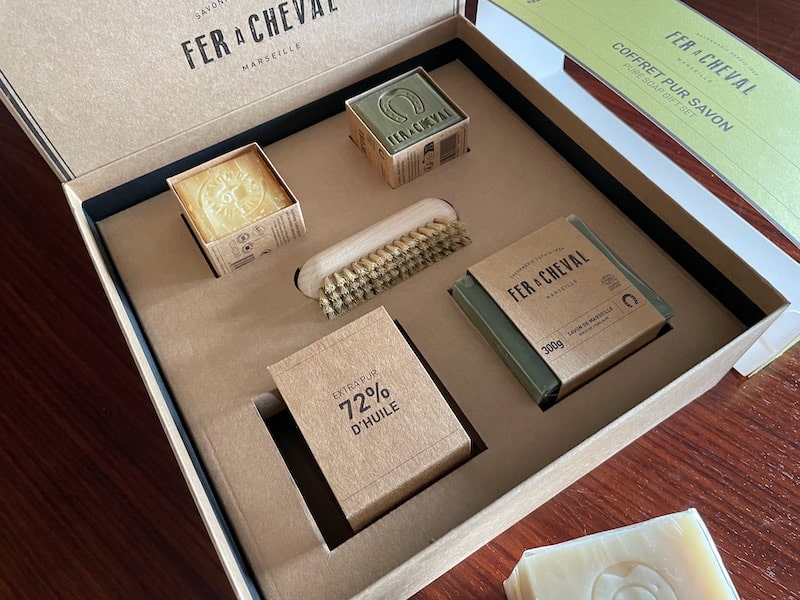 Traditional Marseille soap from one of the oldest manufacturers - I received this for Christmas and this is what got me hunting for authentic Marseille soap ©️Offbeat France/Leyla Alyanak
Traditional Marseille soap from one of the oldest manufacturers - I received this for Christmas and this is what got me hunting for authentic Marseille soap ©️Offbeat France/Leyla AlyanakDoes all Marseille soap come from Marseille?
That answer should seem obvious too, but no. Not at all.
Plenty of Marseille soap comes from Marseille, but other cities can produce the ubiquitous block of soap as well.
Before Marseille became the pre-eminent soap manufacturer of Provence, other cities produced the same soap – and some, like Salon-de-Provence, still do. And call it savon de Marseille. So far, so good.
A bit like Dijon mustard, Marseille soap is an iconic product that isn’t protected by a label of origin. Nor is the name trademarked, allowing pretty much anyone to call their soap Savon de Marseille.
In fact, today, the biggest producers of Marseille soap are China and Turkey, which contributes to endangering the real Marseille soap because 80-90% of the Marseille soap bought today is fake.
At the very least, to qualify as authentic, your soap should come from Marseille and the surrounding areas. I say surrounding because there are two schools of thought about the soap's geographical origins, and two distinct professional associations that represent these differing perspectives.
The controversy around Marseille soap
There are several camps when it comes to what is or isn't Marseille soap, and each camp is represented by its own association.
The UPSM (Union des Professionnels du Savon de Marseille) represents the older, traditional soap-makers and believes that the soap base should be produced in or around Marseille only. It also believes Marseille soap should be made of only two ingredients: vegetable oil and sodium carbonate, with no additives of coloring, and none of those lavender or vanilla scents. Its members include La Savonnerie Fer à Cheval, la Savonnerie Marius Fabre , la Savonnerie du Midi et la Savonnerie Le Sérail
As for the AFSM (Association des Fabricants de Savon de Marseille), it believes the soap base can even come from abroad and that perfumed and colored soaps should also be able to bear the "savon de Marseille" name. It limits itself to soap-makers from Provence – from Marseille and beyond, and includes La Licorne among its six members.
The ASDMF (Association Savon de Marseille France) represents soapmakers from across France and believes that any legislation should focus on how the soap is made rather than where it comes from.
The battle is heated. Those in favor of a wider area of origin for the Marseille soap point out that even the most traditional purists sell perfumed or colored soaps in their shops. As for the producers, the largest Marseille soap producer in France isn't even in Marseille, it's in northwestern France.
So where does that leave us?
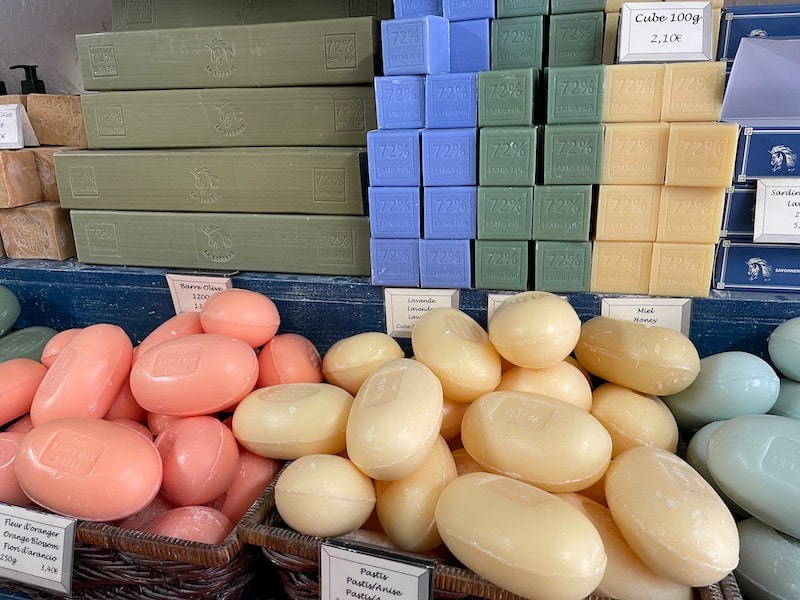 Colored Marseille soaps. Some claim these are perfectly authentic, others not so. There's no right answer
Colored Marseille soaps. Some claim these are perfectly authentic, others not so. There's no right answerSo which is the “more authentic”?
Neither, and both.
There's no official rule about what is or isn't Marseille soap.
However, if you're looking for the most authentic, you'll stick to the beige and olive green soaps, and make sure, when you're buying, that olive oil makes up a substantial portion of the soap.
That doesn't make the colored or perfumed ones any less pleasant, but we're talking "authentic" here. And since there's no official definition, we just have to go with whatever we think best represents what we want.
ORDER YOUR OWN MARSEILLE SOAP!
This is the original Marseille soap, the kind our ancestors have been using for centuries, natural, fresh and pure. I use both this one and one from the Fer à Cheval, another traditional brand.
How savon de Marseille is made
To witness the soapmaking process in Marseille, you have several options.
You can go to the Musée du Savon, especially if you only have one day in Marseille or if you have kids along. The museum is more than a history of soap: it showcases plenty of original equipment, and has a small workshop in which you and your family can make your own soap (and take it home).
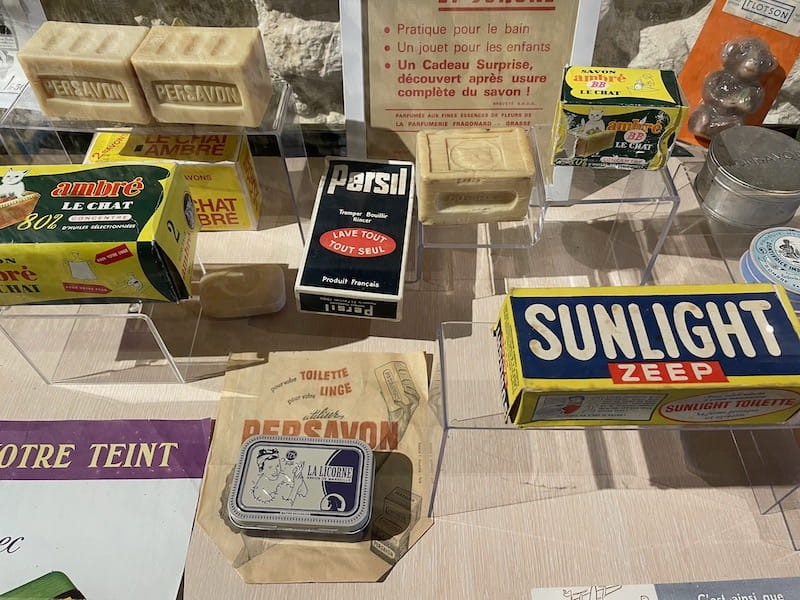
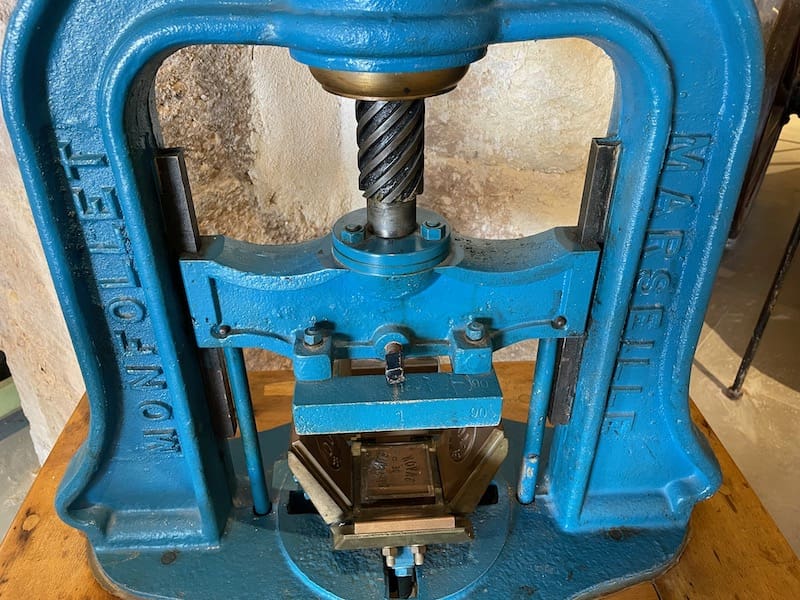 Top: museum exhibit shows old-fashioned soap brands. Bottom: this original piece of equipment is on view at the museum: it was used to press the soap into cubes ©️Offbeat France/Leyla Alyanak
Top: museum exhibit shows old-fashioned soap brands. Bottom: this original piece of equipment is on view at the museum: it was used to press the soap into cubes ©️Offbeat France/Leyla AlyanakYou can also visit one of the several factories.
The museum is owned by the same people who own La Licorne, one of Marseille’s soap makers. I chose this one to visit mostly because of its location on the Cours Julien, where I was planning to have lunch. It’s easy to reach and the staff are friendly and helpful – and you can take as many pictures and videos as you like, which isn’t the case everywhere.
La Licorne has three tours a day (they’re all free) at 11am, 3pm and 4pm. Just show up ahead of time and let them know. The tours are in French but the guides also speak English so you’ll have all your questions answered.
Traditional methods are used to make the soap here and watching the staff and machines at work is fascinating – who knew that a cube of soap started life as as a cylinder which was then transformed into ever smaller flakes?
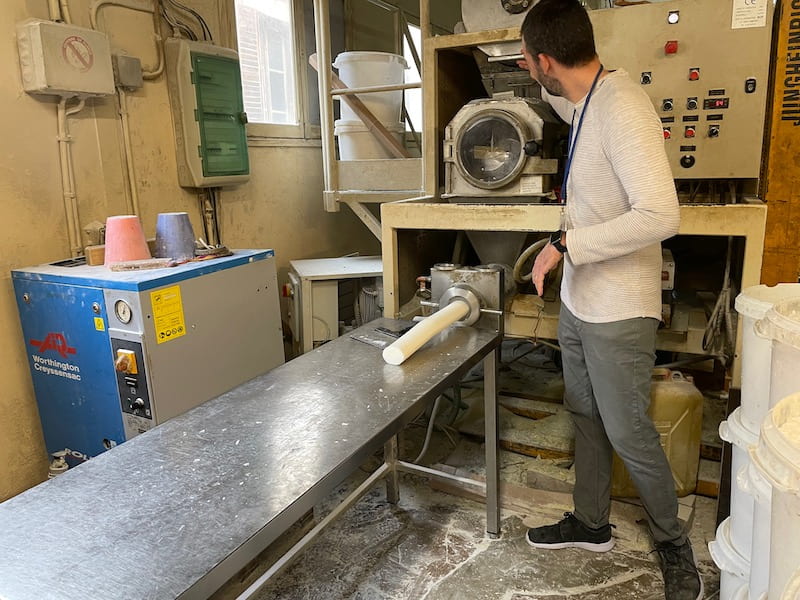
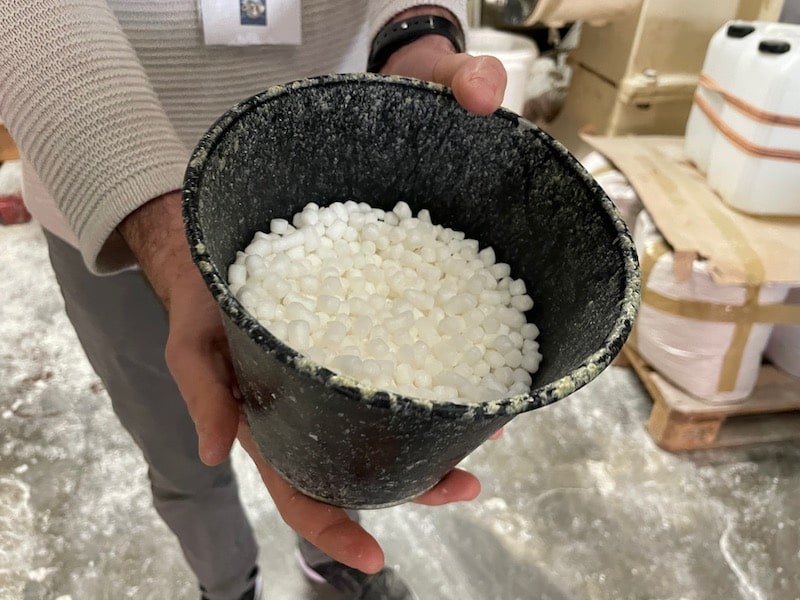
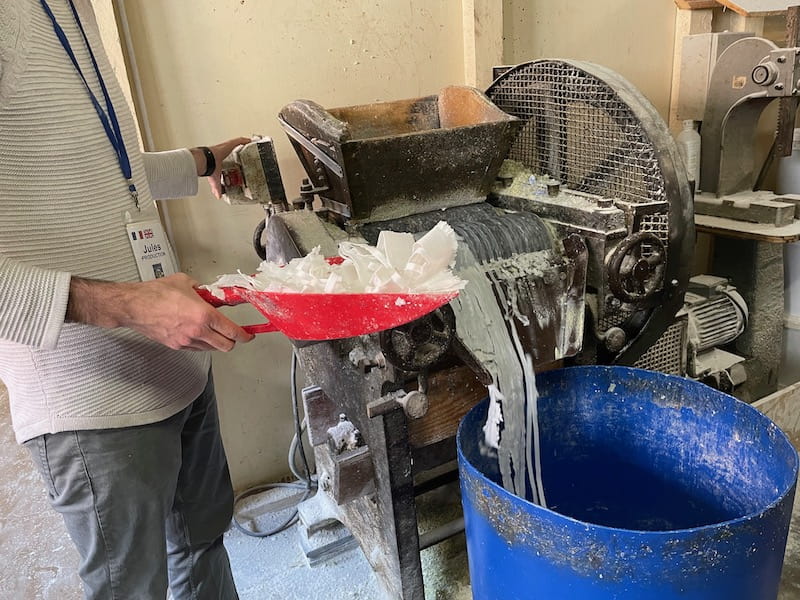 Inside the soap factory. From the top: cylinder of soap; pellets of soap; light sheets of soap. All these will eventually be molded into square soap blocks ©️Offbeat France/Leyla Alyanak
Inside the soap factory. From the top: cylinder of soap; pellets of soap; light sheets of soap. All these will eventually be molded into square soap blocks ©️Offbeat France/Leyla AlyanakThe process is straightforward and hasn’t changed much in centuries:
- First, the saponification, which involves transforming the vegetable oils into soap with lye or soda and heat. This yields large trays of paste, which are washed with sea water to expel the soda.
- The soap is then cooked, or baked, for a week or ten days, after which it is washed again several times.
- The soap is then transferred to molds, is hardened and dried.
- It is then cut into smaller pieces, often squares, and stamped.
Arriving too early for your factory tour?
I can recommend several places in trendy Cours Julien (or Cours Ju’, as the locals call it):
- Maison Loko, a serene restaurant with plenty of vegetarian options and which also serves delicious coffee
- Tabla, a cheerful neo-Egyptian restaurant that surprised me
- The very local Cote Jardin, with delicious affordable food and the feeling you’ve stepped into someone’s living room
- Asabiya for Middle Eastern mezze – it was closed and I was unable to try it but it came highly recommended
Here are more stories about Marseille!
Marseille soap FAQ
What is so special about Marseille soap?
It is wholly natural, inexpensive, and can be used for anything from personal hygiene to household cleaning.
What is the difference between Castile and Marseille soap?
Both have their origins in Aleppo soap from Syria, but Castile soap doesn’t remove the glycerine created during saponification.
What is the smell of Marseille soap?
Traditional Marseille soap has very little smell, especially the white/beige version. The green soap smells a bit of olive oil.
Is Marseille soap vegan?
Yes, 100% vegan.
Where do you buy Marseille soap?
If you’re in Marseille, you can buy it at any factory outlet or shop, like La Licorne or Fer à Cheval. If you’re not, then you can simply order it online. Here’s a fabulous soap from La Licorne on Amazon, and another one from Fer à Cheval, one of the oldest houses.
Before you go…
France is a country keen on traditions, and the savon de Marseille is one of those resilient crafts which has survived industrialization and adapted to the new requirements of sustainability.
And while Marseille soap may never recover its former glory – only a handful of factories are left out of a hundred or so – it’s part of France’s heritage and a modern, natural alternative.
Marseille soap isn’t the only French craft working to survive – look at these traditional Basque products, these enamels from the Bresse region or these gloves from Grenoble.
Did you enjoy this article? I'd love if you shared it!

